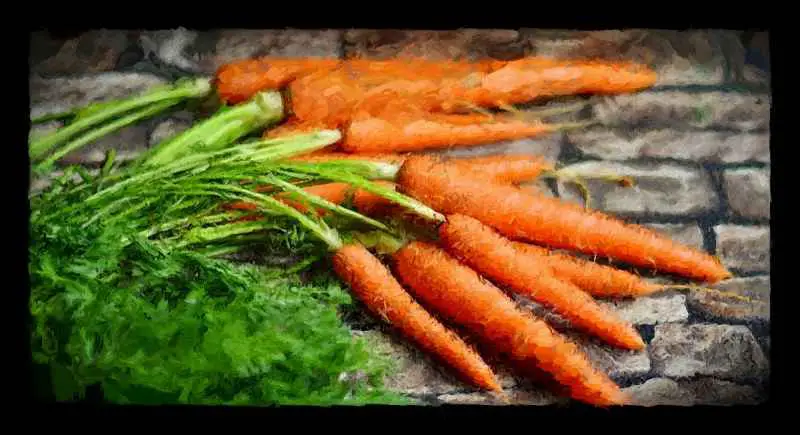Lacto-Fermented Carrots – A Hit Of Probiotic Deliciousness
Can you eat fermented carrots? YOU SURE CAN! Pick one of the next recipes and start making some probiotic goodies right away.
Carrots are amongst the tastiest vegetables to ferment, one of the easiest and definitely one of the most versatile.
They can be lacto fermented with salt or they can be taken through the alcoholic fermentation route to the point where they can even become 14% abv wines.
A bit like watermelons if you think about it: the rinds can be made into pickles and the juice fermented into anything from soda to vinegar.
Both make a wonderful probiotic food and in many cases are also loved by kids, even those who usually screw up their nose at vegetables.
In this post we will share 4 lacto fermented recipes:
- Carrotkraut ( dry salted )
- Grated carrots with ginger ( brined )
- Carrot sticks with garlic and chillies ( brined )
- Carrot wheels with peppercorn and fennel fronds ( brined )
Plus we will give you some tips and answer some of the most common questions related to fermenting carrots at home.
Here we go
Choose And Prepare Carrots
Just like it is with other vegetables you want your carrots to be organic, ripe and as fresh as possible.
Personally I also choose them relatively small because I prefer how they turn out after fermentation.
First things first.
TELL YOUR FRIENDS
Wash carrots in some non chlorinated water ( preferably ); if tap water in your area is chlorinated then you can either boil it or leave it in an open container overnight.
By doing that the majority of chlorine will be eliminated.
If you grow your own produce or buy organic you are free to leave the peel on but if you don’t I would strongly advise you to remove it.
So after choosing, peeling and washing it is time to chop your carrots.
You are 100% free to cut them in sticks, slice them into “carrot wheels” or shred them.
Lacto-Fermented Carrots – What Are They?
Lacto fermented carrots are carrots that have been dry salted or left in a salty solution ( called brine ) for a certain period of time, that’s it.
That’s really all it means.
And if you are wondering whether some form of dairy is involved in the process, the answer is no.
Milk is not involved as the word lacto comes from lactic acid bacteria, the microorganisms responsible for this type of fermentation.
Most of the times, in order to ferment carrots, and vegetables in general, you will have to make a brine so always have the right type of salt handy.
If you don’t know how to make a brine just follow the steps in this post and you’ll be ready to go.
Now let’s see a few recipes shall we?
Fermented Carrot Recipes
CARROTKRAUT – fermented shredded carrots
Ingredients
- Carrots
- Salt
- Water
STEPS
- Weigh you carrots ( without tops and ends )
- Grate or shred them and place them in a bowl
- Add an amount of salt equal to the 3% of carrot weight
- Leave for 1-2 hours massaging the mix every 15-20 min to help carrots release some juice
- Fill up the jars but leave 3 cm / 1 inch of space at the top. Make sure to pack ingredients tightly.
- If vegetables are submerged by their own juice you are set; if they are not, prepare a 3% brine ( amount of salt equal to the 3% of water weight ) and cover them
- Use half an onion, a cabbage leaf or any other weight to keep them covered at all time
- Screw a lid on and let it sit for 10 to 14 days before tasting
- Burp the jar ( unscrew the lid ) every day or so to release some of the CO2
CONGRATULATIONS!
You have just made your first jar of home made fermented carrots!
Let’s keep rolling with recipe number 2.
Would You Like
YOUR FERMIE LIFE
To Be EASIER?
Our FERMENTATION
PRINTABLES Will Do
Exactly That.
Fermented Grated Carrots & Ginger
Ingredients
- Carrots
- Radishes
- Salt
- Water
STEPS
To make these lacto fermented carrots you simply need to follow the process used for Carrotkraut but you will also need to weigh and grate radishes as well.
Recipe number 3 is for the lovers of spicy fermented carrots and if you are like us you won’t get enough of them.
Join Our Community
Fermented Carrot Sticks With Garlic & Chillies
Ingredients
- Carrots
- Fresh garlic
- Fresh chillies or chilli flakes
- Salt
- Water
STEPS
- As always weigh all your ingredients
- Cut carrots into sticks and slice both garlic and fresh chillies
- Place some chillies and garlic at the bottom of the jar then start filling it with carrot sticks
- Alternate carrots with garlic and chillies to evenly distribute flavours
- When the jar is tightly packed cover the sticks with water always remembering to leave enough headspace
- Pour out the water and make a 3% brine
- Repeat steps 7-8-9 of the carrotkraut recipe
Last but not least recipe number 4
Fermented Carrot Wheels With Peppercorns & Fennel Fronds
Ingredients
- Carrots
- Whole peppercorns
- Fennel fronds ( or dill or celery )
- Salt
- Water
STEPS
- Weigh all the ingredients and slice the carrots into half a centimetre thick wheels
- Place some peppercorns and a couple of small fronds at the bottom of the jar then start layering it with carrots.
- Keep the layering going until the top of the jar ( leave enough headspace though )
- Time to prepare the 3% brine necessary to cover the carrots
- Fill up the jar again and with the handle of a wooden spoon gently go through the vegetables to eliminate air pockets
- Repeat steps 7-8-9 of the carrotkrauts recipe
Can you believe that in just a few minutes you have added to your arsenal ( aka cookbook ) 4 amazing recipes to ferment carrots?
Isn’t it awesome?
Now let’s go through a few tips and some very common questions.
DO YOU WANT TO LEARN MORE ABOUT FERMENTING VEGETABLES?
TIPS
As you might have noticed the amount of salt needed to safely ferment carrots is quite significant and not everyone would be happy to eat something this salty.
A very effective way to make these ferments more palatable is to swap the brine with a vinegar based one.
Here is how.
After fermentation is completed simply drain the brine from the carrots and place them back inside the jar.
Aside prepare a vinegar based brine made with 50% vinegar and 50% water and pour it on the carrots until they are fully submerged.
Refrigerate and wait a few days before eating them.
If you have decided to make carrot sticks this is an easy way to prepare them.
Place the whole carrot vertically inside the empty jar to measure how long the sticks should be.
→ Remember: they should sit at least 3 cm / 1 inch below the mouth of the jar.
Fermented Carrots Shelf Life
Lacto fermented carrots can last a few months in the refrigerator which, if you think, is a remarkably long time considering that what keeps them from spoiling is a simple brine.
When it comes to carrot beer instead the time is much shorter; I would say a week in the refrigerator before it turns a bit too sour to be a pleasant drink.
BUT, if you wanted to extend the shelf life of both you could simply pasteurise them with a water bath.
Remember though that with heat you will kill ALL microorganisms; good and bad.
So if on one side you will prevent pathogens from growing, on the other you will also destroy all the probiotics and their beneficial effect on the body.
Fermented Carrots Going Bad
The short answer is yes; of course they can.
But if you follow government food safety guidelines, you sterilise your jars and keep carrots submerged in their brine at all times you will likely have a very smooth fermentation.
The Taste Of Fermented Carrots
Actually they taste very nice, so much so that even kids love them.
Plain lacto fermented carrots ( carrots, water, salt ) maintain their sweetness but, thanks to fermentation, they are enriched with some tang.
If your prefernce is to carry the fermentation for longer, such tang can even be stretched into vinegar like sourness.
A bit like as if carrots had been pickled.
Speaking of pickles try our fermented cucumber recipe and our fermented giradiniera recipe… they are awesome!
When you add other ingredients such as herbs and spices you will be greeted by very complex flavour profiles that are the sum of each individual taste.
All enhanced and transmuted by lacto-fermentation.
That’s why it’s important to begin with very known and tested combinations like the ones we have shared with you in this post.
With time and practice you’ll know off by heart what to add to obtain a specific flavour and what to avoid at all costs because it ruins it all.
And if you wonder how to eat them here is a couple of tips.
Yummy Ways To Eat Fermented Carrots
As a side dish to fish or meat we love to pair carrotkraut with their most famous brother sauerkraut and top the two with some home made shatta sauce.
The above combo also works great if you have a plain and sad hotdog or burger and want to turn it into a wonderful one.
And if you are not a fan of sauerkraut don’t worry!
You can swap them with some fermented garlic scapes that are di-vi-ne with so many dishes.
TELL YOUR FRIENDS
Carrot sticks are a quick, tasty and healthy snack on their own but can take a Bloody Mary or any other savoury cocktail to a whole new level.
Shredded or grated carrots are also the most wonderful addition to sauces like tartar or Danish remoulade.
And how about a fresh and delicious salad with mozzarella chesee, herbs and canned tuna or mackerel?
After all this talking isn’t it time to make something delicious?
As always if you have questions or if you want to share with us some of your experiments and ideas drop us a line in the comment section below.
Thank you for stopping by.
See you soon.






